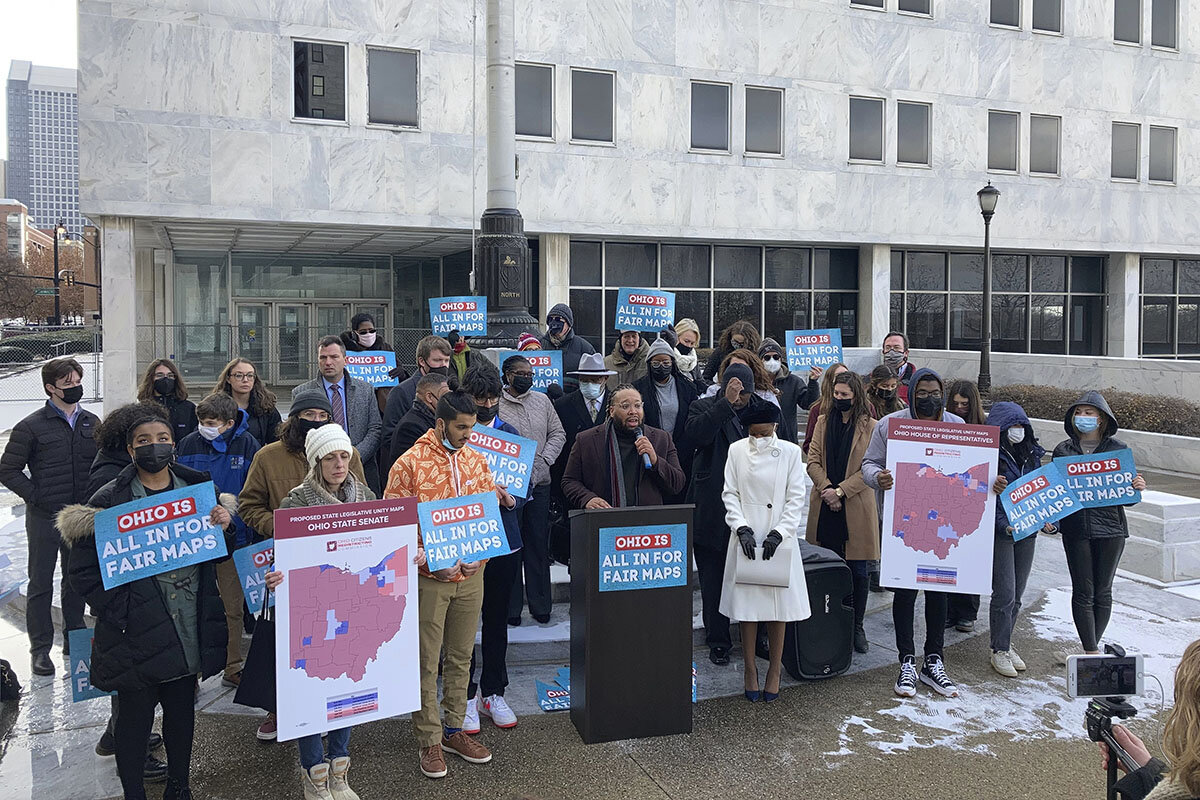A gerrymander foiled in Ohio? Reform advocates see a new model.
Loading...
In recent years, citizen-led efforts to change how states set boundaries for legislative districts have largely focused on the creation of nonpartisan commissions. The idea was to take politics, and politicians, out of the decennial process so that mapmakers could focus on fairness and curb gerrymandering – the delineation of districts for partisan gain.
Ohio took another path.
A redistricting commission made up of politicians from both parties draws the lines for Ohio’s state legislative seats, while lawmakers in the Statehouse decide on congressional maps. But there’s a catch: The maps must comply with a voter-approved constitutional amendment that prohibits gerrymanders.
Why We Wrote This
The battle against partisan drawing of political districts is proving more complicated than reform advocates had hoped. In Ohio, a voter-passed measure at least gives courts a clear standard to uphold.
This month, the Ohio Supreme Court took a hard look at the proposed maps and concluded they gave Republicans an advantage that didn’t reflect the political makeup of the state. In 4-3 rulings, with the Republican chief justice acting as the swing vote, the court ordered up more proportionate districts ahead of this year’s midterm elections – a rebuke to Republicans who hold three-quarters of Ohio’s congressional seats and a veto-proof majority in Columbus.
“When the dealer stacks the deck in advance, the house usually wins,” wrote Justice Michael Donnelly in the majority opinion.
The recent failure of Democrats to enact voting rights legislation in Washington has underscored the limits of federal oversight of how states run elections. Among other measures, the bill would have prohibited the types of gerrymanders that both parties have long employed for political advantage. Senate Republicans criticized the voting rights bill as federal overreach based on false claims of voter suppression.
The bill’s failure shows the need for reform advocates to focus on state laws, says David Pepper, a former Democratic state chair in Ohio. “We now have standards in court to enforce these new rules” in Ohio, he says.
The congressional map that the court rejected would have created 11 Republican-leaning seats and two safe seats for Democrats, along with two competitive seats. The court compared this with average statewide vote shares of 54% for Republicans and 46% for Democrats.
Over the weekend, Ohio’s redistricting commission published a new set of maps that Democrats also refused to endorse, cuing up another court review.
“I was hopeful that there would be a consensus between the Republicans and Democrats, but evidently that proved impossible,” , one of five Republicans on the commission.
One challenge in designing proportionate districts is the geographic sorting of Democrats and Republicans into urban and rural areas, with Democratic voters increasingly concentrated in cities. Republicans point out that the redistricting commission is mandated to draw “compact” districts that keep communities together, and that the GOP-favored maps would have done this. When he approved the congressional map back in November, GOP Gov. Mike DeWine called it “fair, compact, and competitive.”
Experts on redistricting agree that the criteria for drawing fair maps – proportionate to the state’s partisan leanings, but also with compact boundaries and competitive races – can be in tension with each other.
“If your goal is to draw competitive seats ... geographical sorting makes things quite difficult,” says Adam Podowitz-Thomas, senior legal strategist at the Princeton Gerrymandering Project. But, he adds, “it’s often used as an excuse why rough measures of partisan fairness can’t be achieved, and that’s not true.”
The clock is ticking: Feb. 1 is the deadline for candidates filing for primaries. The legislature has until mid-February to agree on maps for federal elections. Ohio is losing one of its 16 seats in the U.S. House of Representatives, as one of seven states whose congressional delegation will shrink due to shifts in population.
“What we’re doing here in Ohio is critical. We want to make sure the people of Ohio have fair representation in Congress and in the Ohio Statehouse,” says Jen Miller, executive director of the League of Women Voters of Ohio, the lead plaintiff in the congressional redistricting case.
Legal challenges across the U.S.
In 2019, the U.S. Supreme Court ruled that partisan gerrymanders were “political questions” that federal courts had no clear way to adjudicate. That put the onus on state courts to hear lawsuits over redistricting, including alleged racial discrimination in drawing boundaries. Federal statutes on civil rights and redistricting also allow for such cases to be tried there.
Disputed 2022 maps are the subject of lawsuits in North Carolina and Wisconsin, two battleground states where Republicans have outsize majorities in the legislature as a result of aggressive gerrymanders in the last redistricting a decade ago. Both have Democratic governors who oppose the GOP-drawn maps that are being challenged in state supreme courts.
But Ohio’s constitutional amendment sets it apart from states where partisan maps are being litigated without any specific anti-gerrymandering laws on the books, says Douglas Spencer, an associate professor of law at the University of Colorado who studies redistricting.
While courts in North Carolina and Pennsylvania have struck down skewed maps in the past on the basis of constitutional safeguards for free and fair elections and equal protection, “that’s not explicitly about redistricting. There’s no guarantee about what fairness should be,” he says. “State courts have to uphold some kind of law, and those laws don’t exist in every state.”
In Florida, which gains a House seat this year, maps drawn by legislators must also satisfy voter-approved anti-gerrymandering amendments to its state constitution. In the last cycle, courts invalidated maps crafted by GOP consultants. Florida’s Legislature is now wrangling over new districts for 2022.
Ohio’s efforts to curb partisan mapmaking began with a defeated ballot measure to create an independent commission in 2012. Since then, several other states have adopted that approach, with mixed results.
In Virginia and New York, nonpartisan commissions deadlocked this cycle, so courts and legislators stepped in. Michigan’s commission was more successful in finding consensus, though Black lawmakers objected to how seats were drawn in and around Detroit. Other states adopting this model include Arizona and Colorado.
Watchdog groups that score maps for partisan bias say states with independent commissions still tend to produce fairer maps than those where lawmakers control the process, including in Democratic-run states like Maryland and Illinois.
“We played the long game”
After failing to create an independent commission, reform advocates in Ohio – a former swing state that now tilts Republican – tried another tack.
In 2015, voters were asked if they wanted a bipartisan commission to draw proportionate district lines. The proposal, which passed with 75% support, created a commission of four lawmakers, two from each side of the aisle, and three statewide executives, who are currently all Republicans. If lawmakers from either side object to the final maps, they must be redrawn after four years.
In 2018, voters approved by a similar margin a constitutional amendment to prohibit partisan gerrymandering, setting a legal standard to uphold.
“It still left the politicians in the room,” says Mr. Pepper, who worked on the reform campaigns. As Democratic state chair, he also raised money to help elect more Democrats to the Ohio Supreme Court. “We played the long game,” he says.
But the fact that most state justices are elected, unlike federal judges, highlights a weakness in anti-gerrymandering reforms that rely on judicial review.
“I think this Ohio case demonstrates state courts are perfectly capable of stepping in and applying standards of fairness to redistricting,” says Yurij Rudensky, a redistricting counsel at the Brennan Center’s democracy program, which joined one of the lawsuits against the redistricting commission.
But, he adds, state “judges don’t have as robust protections that insulate their judicial independence from political retaliation.”
Three of Ohio’s Supreme Court justices are up for reelection in November. Mark Weaver, a GOP strategist in Ohio, says Republicans will try to expand their court 4-3 majority in time for the next redistricting round in four years. The GOP-run legislature last year changed the ballot so that judicial nominees are listed with their party affiliation; previously they were only listed by name on the ballot.
“Given that our state leans red now significantly, and most people don’t research a lot about Supreme Court races, it’s not hard to predict that Republicans will do better on the court,” he says.
He also plays down the impact of the court’s rejection of the Republican-drawn maps, given the favorable political environment for Republicans right now in a state they already dominate. “The only question is will there be a veto-proof supermajority,” he says.






